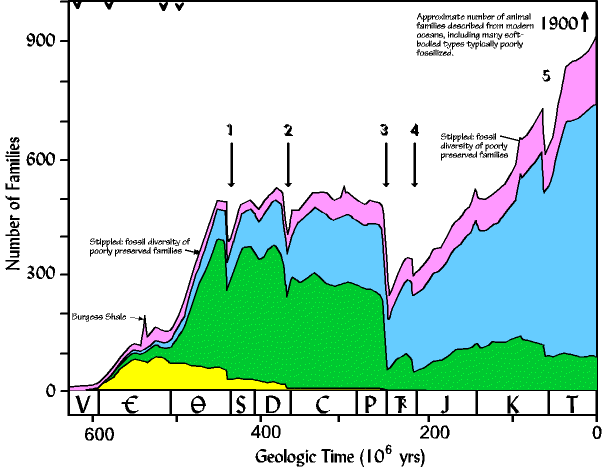
| Palaeos |  |
Ecology |
| Life | Evolutionary Biota |
| Page Back: Biomes | Page Up: Life | Unit Home | Page Next: Trophic Levels |
| Unit Back: Systematics | Unit Up: Life | Unit Up: Palaeos | Unit Next: Astrobiology |
| Life
Evolution Paleontology Systematics Astrobiology Life on Earth |
Biomes
Biota Trophic Levels & Groups Guilds Glossary References |
On the basis of statistical analysis of shelly marine fauna (which tend to be easily fossilized) Jack Sepkoski has found that marine mostly invertebrate communities can be broken down into three separate evolutionary faunas. These are shown in the following diagram (Sepkoski's original having been reproduced a number of times) in which each taxon is measured in terms of diversity (number of families):

In this diagram, the Cambrian fauna (or Trilobite fauna) is shown in yellow, the Paleozoic fauna (or Brachiopod fauna) in green, and the Modern fauna (or Bivalve-Gastropod fauna), in blue. The purple field indicates soft bodied organisms, and not representative of total diversity (because these creatures are only very rarely fossilized, the famous Burgess Shale lagerstätten is shown here as a "spike"; other lagerstätten like Chengjiang and Sirius Passet have only more recently been discovered.
The terms Cambrian, Paleozoic and Modern are in a sense misleading, because representatives of all three categories already existed in the Cambrian, and each persist until the present day (although some or many of the species and clades may have become extinct. However, these biotas can be grouped together because they tend to be common or rare at the same time. For example at the end of the Cambrian, the Cambrian fauna (yellow) begins to slowly decline, while the Paleozoic fauna (green) undergoes an evolutionary radiation, increasing greatly in abundance and diversity during the early Ordovician.
The five numbered arrows each represent a mass-extinction event, the effect of which can be seen in a sharp decline in the diversity of the various faunas. Note that several Cambrian and early Ordovician mass extinctions are not shown here.
In their book on palaeoecology, Benchley and Harper 1998 suggest three additional evolutionary biotas before the Cambrian. These they call the Pre-Vendian, the Vendian, and the Tommotian. All of which gives us the following:
The Pre-Vendian biota consists mostly of microorganisms and extends almost the entire span of the Precambrian.
The Vendian evolutionary biota includes the enigmatic Ediacaran fauna, which seems to be a combination of organisms (the so-called Vendobiota) unrelated to any living Metazoa, along with possible metazoan ancestors. Elements of the Vendian biota survived into the Cambrian.
The Tommotian evolutionary biota is made up of "coat of mail" animals that left behind small shelly fossils, as well as archaeocyaths and other early groups. This diverse and often paraphyletic (ancestral) assemblage of early metazoans includes a number of elements that survived into the mid or even late Paleozoic
The Cambrian evolutionary biota includes such representative taxa include trilobites, hyoliths, monoplacophorans, inarticulate brachiopods, and primitive echinoderms. A recent "living fossil" representing this fauna is the brachiopod Lingula, barely changed in 500 million years.
The Paleozoic evolutionary biota includes organisms that flourished from the Ordovician to the Permian, but are now relatively rare. Representative taxa include articulate brachiopods, stony and lacy bryozoans, stromatoporoids, cephalopods, crinoids and blastoids, starfish, and graptolites
Finally, the Modern evolutionary biota emerged in the wake of the end-Permian mass extinction, and is still rapidly diversifying. Examples include bivalves, gastropods, vertebrates, echinoids, crustaceans, and gymnolaemate bryozoans. As Benchley & Harper have observed: "The Modern evolutionary marine biota radiated after the end Permian extinction event with mobile detritus-feeders both epifaunal and infaunal dominating the seascapes previously occupied by the sessile suspension-feeding benthos. The Mesozoic marine revolution was apparently driven by an arms race (Vermeij, 1987). Thicker shells and the ability to burrow deeper were matched by a variety of improved predatorial skills including the evolution of more advanced jaw mechanisms in groups such as the crustaceans. Moreover specific adaptations such as the evolution of cementation have been related to the appearance of molluscivorous predators."
| Page Back: Biota | Page Top | Unit Home | Page Next: Trophic Levels |
MAK020603
last modified ATW070113
